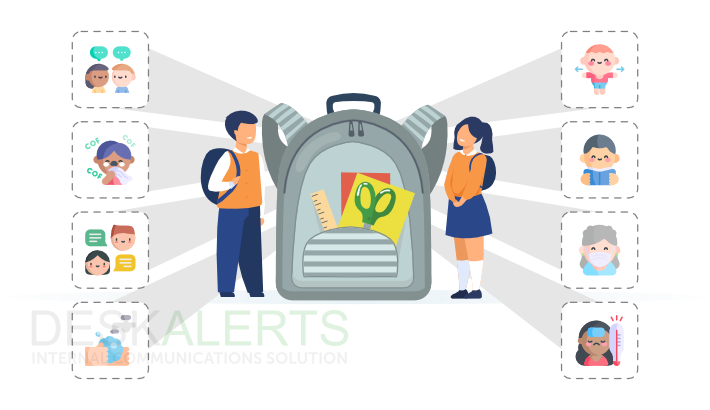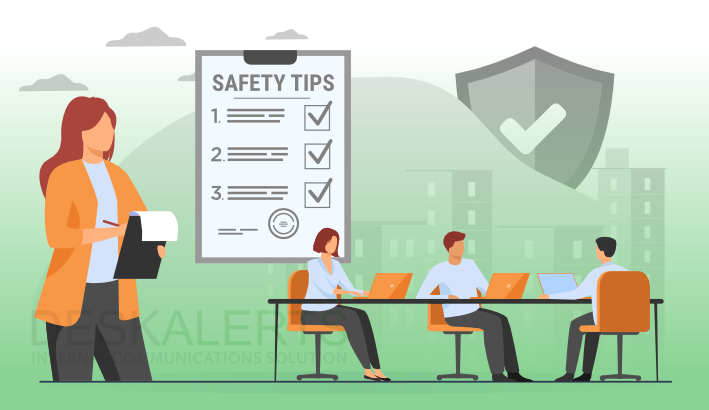
Ensuring a steadfast focus on student safety is paramount for educational institutions. Schools serve not only as centers of learning but also as environments where students spend a significant portion of their formative years.
Safety concerns, both physical and emotional, can profoundly impact students' well-being and academic success. By prioritizing student safety, schools create an atmosphere conducive to learning, where students feel secure to explore, engage, and thrive.
Table of Contents
1. Why schools need to prioritize student safety
2. The top 10 safety rules for kids at school
3. Why communication is important for school safety
Why schools need to prioritize student safety
From ensuring physical security to promoting emotional and psychological safety, creating a safe school environment is crucial for the holistic development of students. Here are several reasons why safety in schools is of utmost importance:
Physical protection
The primary reason for prioritizing safety in schools is to protect students, staff, and visitors from physical harm. Implementing measures such as secure entry points, surveillance systems, and emergency protocols helps mitigate risks associated with violence, accidents, and external threats.
Emotional well-being
Feeling safe emotionally is just as important as physical safety. Schools should be nurturing environments where students feel comfortable expressing themselves without fear of ridicule or judgment. Emotional safety enables students to focus on their studies and social interactions, fostering healthier relationships with peers and educators.
Promoting learning
A safe school environment is conducive to learning. When students feel secure, they are more likely to engage in academic activities, participate in class discussions, and explore new ideas. Conversely, in an unsafe environment, students may be preoccupied with concerns about their safety, hindering their ability to concentrate and learn effectively.
Preventing bullying and harassment
Safety measures in school for students can help deter and address bullying and harassment, which are pervasive issues in many schools. By promoting a culture of respect and empathy and implementing anti-bullying policies, schools can create an atmosphere where all students feel valued and supported.
Supporting mental health
Students' mental health is closely linked to their sense of safety and well-being at school. Addressing safety concerns can contribute to reducing stress and anxiety levels among students, thereby supporting their mental health. Additionally, providing access to counseling services and resources can help students cope with any emotional challenges they may face.
Preparing for emergencies
Safety protocols and drills prepare students and staff to respond effectively to emergencies such as fires, natural disasters, or intruders. By practicing these procedures regularly, schools can minimize panic and confusion during crisis situations, potentially saving lives.
5 EMERGENCY MESSAGE TEMPLATES FOR SCHOOLS
Legal and ethical obligations
Schools have a legal and ethical responsibility to ensure the safety of everyone on campus. Failure to implement adequate safety rules at school can lead to legal liabilities and damage to the school's reputation. By proactively addressing safety concerns, schools fulfill their duty of care to students and staff.
The top 10 safety rules for kids at school
Here are 10 essential safety rules for kids designed to equip them with the knowledge to navigate their school environment securely:
- Know emergency procedures
Familiarize yourself with emergency procedures and other classroom safety rules such as fire drills, lockdown drills, and evacuation routes. Pay attention during safety drills and follow instructions from teachers and staff promptly.
Always use the buddy system, especially when moving around the school premises or during outdoor activities. Stick with a friend or group of friends, and look out for each other to ensure everyone stays safe.
- Stay visible and supervised
Avoid secluded areas of the school where there are no adults or surveillance cameras. Stick to well-lit and supervised areas to minimize the risk of accidents or unwanted encounters.
- Report suspicious behavior
If you see something unusual or someone behaving in a way that makes you feel uncomfortable or unsafe, report it to a teacher, school counselor, or any trusted adult immediately. Never ignore your instincts when it comes to safety concerns.
Always use designated pathways and crosswalks when moving around the school campus. Avoid shortcuts through parking lots, alleys, or areas with heavy traffic to reduce the risk of accidents.
Practice internet safety by being cautious about sharing personal information online. Avoid interacting with strangers and report any instances of cyberbullying or inappropriate content to a teacher or parent.
- Respect personal boundaries
Respect the personal space and boundaries of your classmates and teachers. Avoid rough play or physical contact that could lead to accidents or conflicts.
- Follow safety equipment rules:
Whether it's wearing helmets during sports activities or using protective gear in science labs, always follow safety equipment rules to prevent injuries.
- Proper use of school equipment
Use school equipment such as playground equipment, sports gear, and classroom supplies responsibly and according to the instructions provided by teachers. Improper use can lead to accidents and damage.
If you witness bullying, harassment, or any form of mistreatment towards yourself or others, speak up. Be an advocate for safety and inclusivity in your school community by reporting incidents and supporting those in need.
Adhering to these 10 safety rules in classroom and other environments on campus can prevent students and staff from coming to serious harm.
SCHOOL ALERT SYSTEM FOR 2025-2026

Why communication is important for school safety
Communication is vital for school safety as it ensures that all stakeholders are informed and prepared to respond effectively to emergencies. It fosters a collaborative approach, enabling timely dissemination of information, identification of potential risks, and implementation of proactive measures to mitigate threats and promote a safe environment for all. Best practice tips for communicating school safety are:
- Ensure that safety policies and procedures are clearly communicated to all stakeholders through school handbooks, websites, and orientation sessions.
- Conduct regular safety training sessions and drills to educate students and staff on emergency protocols and procedures. Practice scenarios such as fire drills, lockdown drills, and evacuation procedures to reinforce preparedness.
- Establish open communication channels between students, parents, teachers, and administrators to address safety concerns promptly. Encourage students to report any safety issues they encounter and provide anonymous reporting options if necessary.
- Utilize technology such as a mass notification system like DeskAlerts, mobile apps, and digital platforms to disseminate safety information quickly and efficiently.
- Foster a culture of safety by integrating safety awareness into the school curriculum, organizing safety-themed events, and recognizing individuals who contribute to maintaining a safe environment.
HOW DESKALERTS IMPROVES COMMUNICATION IN EDUCATION
***
By implementing these strategies, schools can effectively create a safer environment for teachers and students alike, empowering their stakeholders to cultivate secure learning environments for all through adherence to school safety rules.
FAQ
What are the most common safety rules at a school?
Common safety rules to be followed in school include understanding and carrying out emergency procedures, reporting concerns to teachers, using designated pathways, respecting personal boundaries, wearing safety equipment, avoiding rough play, adhering to online safety guidelines, and seeking adult assistance when needed.
What are the 10 general safety rules?
10 safety rules at school for students include:
- Always wear appropriate safety equipment.
- Follow instructions and guidelines provided by supervisors.
- Keep work areas clean and organized to prevent accidents.
- Report any hazards or safety concerns immediately.
- Use tools and machinery correctly and safely.
- Be aware of your surroundings and potential hazards.
- Take breaks and rest when necessary to avoid fatigue-related accidents.
- Avoid horseplay and reckless behavior.
- Practice proper lifting techniques to prevent back injuries.
- Attend safety training sessions and follow established protocols for emergencies.
What is safety rules for kids?
Safety rules for kids include using the buddy system, staying supervised, reporting concerns, using designated pathways, avoiding sharing personal information online, and showing kindness to others.
How can students be safe in school?
Students can learn how to be safe at school by following safety protocols, using designated pathways, reporting concerns to adults, respecting personal boundaries, practicing online safety, and fostering a supportive and inclusive environment through kindness and empathy.
 Caroline Duncan
Caroline Duncan








